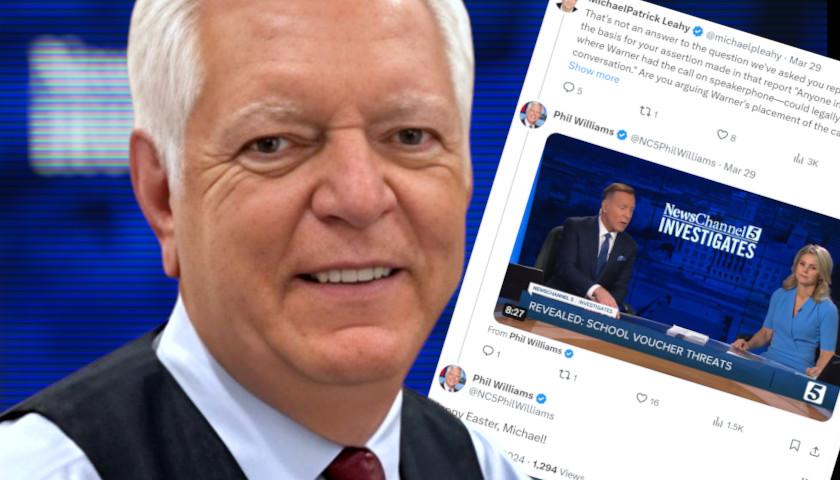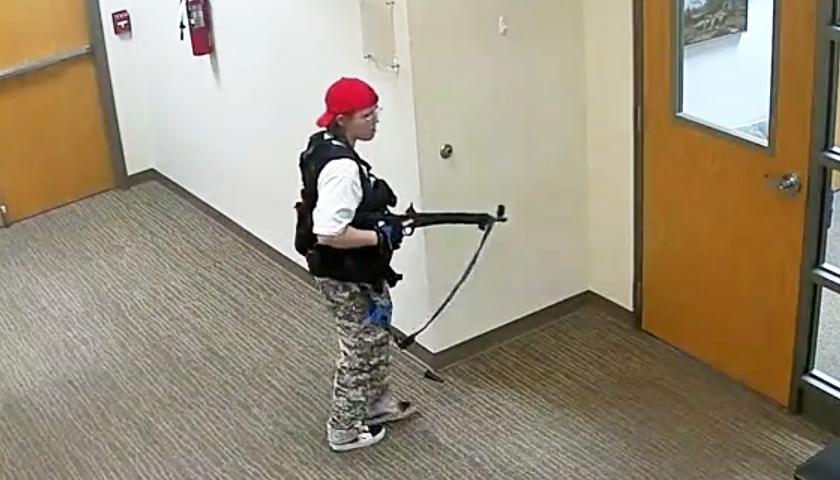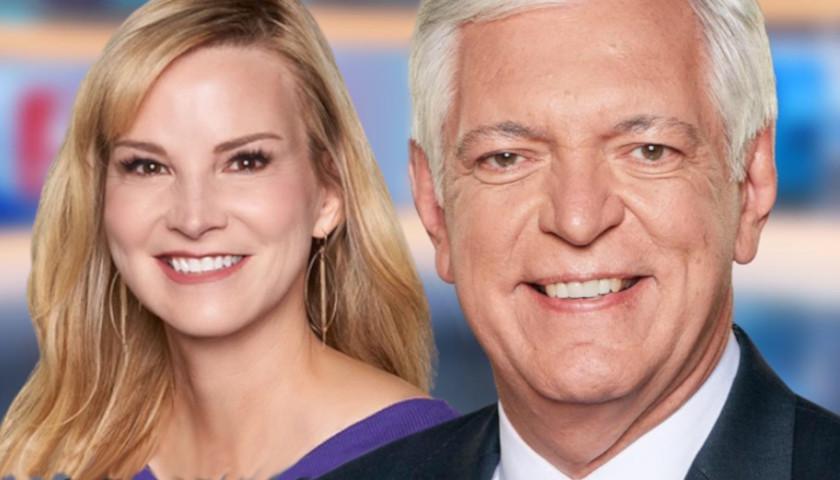Live from Music Row Friday morning on The Tennessee Star Report with Michael Patrick Leahy – broadcast on Nashville’s Talk Radio 98.3 and 1510 WLAC weekdays from 5:00 a.m. to 8:00 a.m. – host Leahy welcomed the original all-star panelist Crom Carmichael in studio to talk about their shooting competition at the GlockStore in Nashville.
Leahy: Tomorrow you and I are going to be at the third annual open house at the GlockStore, 1930 Airlane Drive. They’ve got a lot of good stuff going on. They’re going to give away a Glock tomorrow. They’ve got over $10,000 worth of raffle bags. They’ve got some shooting competitions. And Glock handguns are $50 bucks off—lots of interesting speakers. I think Congressman Andy Ogles will be there. I think one of us is going to talk about the Constitution. I think maybe it’s me.
Carmichael: I think it’ll be you.
Leahy: It’ll be me. Yes. But I have to say this, Crom. You and I had some fun there.
Carmichael: Yes, we did.
Leahy: It was a lot of fun actually, we had a shooting competition
Carmichael: Preceded by four lessons.
Leahy: Preceded by four.
Carmichael: The most important part of it.
Leahy: Because as we were describing it and I think you, you started out with a higher capability than I have.
Carmichael: You think so?
Leahy: You had a little bit tad more experience. But as I told Dan Jones, who’s the marketing director at the GlockStore in this little YouTube video that, by the way, it’s up at The Tennessee Star.
Carmichael: The very first time I ever shot a handgun I was actually with you at the GlockStore.
Leahy: Oh, that was the first time. Okay, good. Maybe you didn’t have as much of a comparative event. Maybe you are just naturally better.
Carmichael: I knew how to stand because I watch more TV. (Laughs)
Leahy: There you go. But as I started off kind like below negative zero and with the training we got there on the, on, on how to fire a pistol. I think I’ve moved into positive territory and I’ve just really enjoyed going from, to be honest, timid to being more confident now.
Carmichael: There were three different, I don’t know, co-subtests that made up three rounds of competition. Three, three rounds of competition. And each was different.
Leahy: Different format for each one.
Carmichael: And I am confident that you beat me on the third.
Leahy: And I’m confident that you beat me on the first.
Carmichael: So we don’t know. So we don’t know.
Leahy: I think you really beat me on the first.
Carmichael: We don’t know what the difference was then because I truly don’t know who won.
Leahy: Yes, we don’t know.
Carmichael: We do not know who won. But I know that I’m confident that you beat me on the third one, and if you’re confident I beat you on the first one that’s come down to the second row because everyone is measured. So it’s not like he won the first, he won the second. And so it’s not like that because each one is timed and then scored, and so it’s cumulative of the three.
Leahy: And so just to describe these rounds, which I thought was very interesting. The first round was really relatively easy. They had three close-up targets and four targets a little bit further back.
And the way they do this is you have a target with a white sheet of paper and an outline of a person, and then the white sheet has a diamond in it. If you hit the diamond, they don’t add extra time, right? And if you’re on the white paper, but you miss the diamond, they add 30 seconds.
Carmichael: No, a quarter second.
Leahy: A quarter of a second.
Carmichael: A quarter of a second. And then, if you hit the brown cardboard, they add half a second. And if you miss everything, then they add one second.
Leahy: Is it a second?
Carmichael: One second. If you hit everything, if you miss everything.
Leahy: Good point. And so then the easiest round, I was not in the zone. And, of course, you were out there watching me and tying me, this is funny. This is the Cromster. He always has fun. So I went first on the first round, and you could watch me, and we were in this private room, but you could see the video of it.
And you actually timed me so you knew what the time to beat was. You clever so and so? (Carmichael chuckles) Very clever. You love that kind of stuff. But it’s weird because the first targets were like three feet away, and I didn’t do very well in the easy targets. I hit the farther one away.
Carmichael: Wow.
Leahy: Oh, you, so you didn’t know that?
Carmichael: I didn’t. I only knew the time. I didn’t know how you did on the targets.
Leahy: The first three targets, surprisingly, I was not in the zone. My brain wasn’t there. So I think you really destroyed me in the first round.
Carmichael: Now, what I found interesting is our instructor, who is a very good instructor and a very accomplished marksman. Served in the military. Wonderful guy. Wonderful guy.
He told us this is the sequence that you should approach this first round of competition; you ought to aim at this particular target first, this particular target second, which was the far one then the close one, then the far one, then the close one. And you decided to go your own way.
Leahy: That was a mistake.
Carmichael: That was a mistake. And so rather than take the expert’s advice, and this is very much you, by the way. Yeah, it is. You do not take the expert’s advice. You’d rather prove experts wrong. And you usually don’t. (Laughs)
Leahy: I proved this expert right because the tactic here, Crom, was you got the three close targets, but geographically, if you, as you go, like with a wheel of the distance, the natural slowest movement would be a short target. Two long targets in the middle would be short targets.
And then two long targets to the right and then to the far right, another short target. And I thought, incorrectly as it turns out, that instead of like slowly moving across, it would be better to hit the short targets first and then circle back and hit the long targets. That was a tactical mistake on my part.
Carmichael: So what you’re saying is what you cleverly did was you missed all three of the short targets first and then did better on the two long targets.
Leahy: Sort of. Yes. (Carmichael laughs) Obviously, this is why you should listen to the experts.
Carmichael: That’s right.
Leahy: Which I didn’t do.
Carmichael: That’s right. I paid close attention to the expert. I followed the recommendations.
Leahy: But now I have learned that lesson very well. But what then happened is the tactical objects where you had hostages. It was far more difficult. For the second and third rounds, I was in the zone. And I think like in the last round of the 14 shots and seven targets, I think I had 13 right in the center of the target.
Carmichael: Oh, good.
Leahy: And then I think I won just on the edge.
Carmichael: You may have won the contest.
Leahy: I don’t know. I was really bad in the first round.
Listen to today’s show highlights, including this segment:
– – –
Tune in weekdays from 5:00 – 8:00 a.m. to The Tennessee Star Report with Michael Patrick Leahy on Talk Radio 98.3 FM WLAC 1510. Listen online at iHeart Radio.
Background Photo “GlockStore” by GlockStore Retail Nashville, TN.









I learned how to shoot long guns when I was a young kid. My first duck hunting trip was when I was seven. The shotguns I used got bigger as I got bigger. I started using rifles with scouts in high school, 22s at fifty feet with the Cat tractor gun club every week. The center of the bullseye was the size of a bullet, we had iron sights and military (WWII) slings, and we shot prone, sitting, and offhand. I could hit a bullet with a bullet almost every time…every time prone the last three years of high school. We shot hand thrown clays over a backwater bay of the river at that time. they are slow and I never missed with a 12 gauge.
Fast forward to this old man: I hope never to be in a hurry to pull a trigger, or too slow to pull on a target in my sights. I’ve spent some part of 50 summers within a few miles of the edge of the northern wilderness up in Canada on a private island in a lake with 1000’s of other islands. I’ve protected children at a church camp along with a Mounty to whom I loaned my WWI rifle while I kept my shotgun with rifled slugs. I skinned two bears that day. I’ve walked (quickly) outside in running shorts and flip-flops to come between a bear and two young daughters in one direction and my Mom and pregnant wife in another…armed with a shotgun with one round of #6 shot in it. Not ideal! But I had a plan: If it charged me I would wait until it was just upon me and then shoot it in the eye (a path to the brain surrounded by thick skull bone) and I might live. But having a plan counts and the bear started up a small rise into the woods so I shot it in the backside and it ran faster.
I too have just begun to learn how to hit what I’m aiming at with a handgun, but the other evening I used a 20 gauge to shoot an armadillo playing with two others just out back of my house. Long guns if you’ve got them! Use them and they will become a good tool!